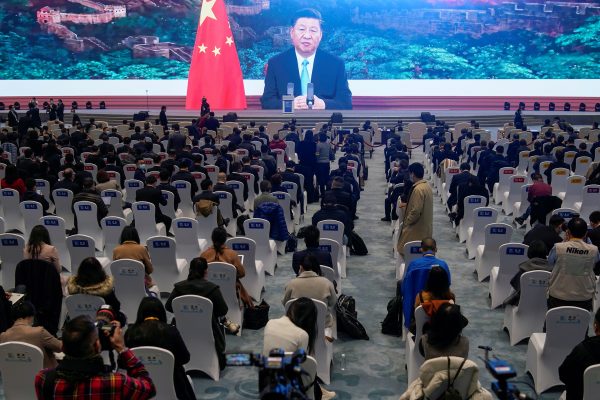The extent of China’s high-tech ambitions under President Xi Jinping are evident in a series of policy initiatives. Since 2014, dramatic reforms have overhauled China’s science funding system. In 2015, the Made in China 2025 (MIC2025) program prioritised state support for 10 high-tech sectors and called for 70 per cent self-sufficiency in core components and basic materials by 2025. In 2017, China unveiled plans to become the ‘world’s primary artificial intelligence innovation centre’ by 2030.
Underpinning these ambitions is growing investment in technology. By 2018, China’s share of world research and development (R&D) investment stood at 22 per cent — second only to the United States’ share at 25 per cent. China is expected to take the lead before 2025. Roughly three quarters of China’s R&D investment comes from business. Still, government officials remain deeply involved in the allocation of capital, not only through state-owned banks but also through other means, including government-guided investment funds.
China’s growing list of S&T achievements do not simply reflect the influx of investment. China’s performance may be most impressive in basic science, even though China invests less in basic research as a share of national R&D spending than other science leaders do. China’s remarkable performance is evident in the Nature Index, which tracks how often scientists from different countries publish in the world’s top journals. While the United States still leads, China’s score has surged from 24 to 67 per cent of the US score since 2012.
China’s rise in basic science reflects in part the intense pressure on its scientists to publish top-tier articles within short time horizons, though this also generates academic misconduct, including plagiarism and faked peer review. China’s performance also demonstrates the remarkable degree of collaboration between the US and Chinese scientific communities, as reflected in student flows, academic exchanges and joint research. China has emerged as far and away the leading source of co-authors for US scientists.
China’s performance on the corporate side is more mixed. Huawei’s leadership in 5G is impressive and well-known, though its hardware reportedly has more vulnerabilities than that of other vendors. Chinese firms also lead in some areas of artificial intelligence, such as facial recognition.
China also boasts a vibrant start-up scene, with 24 per cent of the world’s ‘unicorns’ (private start-up firms valued over US$1 billion). While China’s unicorn share still lags that of the United States (48 per cent), it greatly exceeds that of third-place India (5 per cent). China’s total also includes the world’s two most valuable unicorns — ByteDance and Didi Chuxing.
In other regards, Chinese firms are less impressive. For one, China’s share of the world’s most valuable listed firms has changed little over the past decade. As of 2020 ‘Greater China’ boasts 14 of the world’s top 100 firms by market capitalisation — a modest increase from 11 in 2009. US firms, in contrast, comprise 57. While China does have two firms — Alibaba and Tencent — in the top 10, five of the top six are US tech firms.
China’s high-tech ambitions are facing new challenges under Xi Jinping. Tighter internet controls have prompted complaints from elite Chinese scientists about the impact on research. In 2017, Vice Chair of the Chinese People’s Political Consultative Conference, Luo Fuhe, called attention to the problem only to have his remarks censored. The CCP has also tightened its grip on university campuses. In 2016, for example, Tsinghua University’s party secretary said faculty members’ political stances would be given top priority in performance evaluations.
On the corporate front, Xi prioritises China’s state-owned sector, even though non-state firms are generally more dynamic and innovative. While private firms are still valued, their proverbial wings have been clipped, as shown in the recent suspension of Ant Group’s IPO. Private firms must now accept greater CCP presence than before and balance business goals with those of the Party. This is likely to further limit the efficiency with which China turns innovation inputs into outputs.
The international environment is also becoming less friendly to China’s rise, increasingly apparent beyond the United States. Officials from the EU to Japan are scrutinising incoming high-tech investments more closely. In October, Sweden became the latest country to ban Huawei from its 5G networks. India has banned more than 200 mostly Chinese apps.
The ominous international environment, combined with China’s growing high-tech capabilities, is accelerating the country’s drive for technological autonomy. In October 2020 Chinese leaders vowed to focus efforts on ‘scientific and technological self-reliance’. This commitment must be taken seriously given China’s remarkable progress to date. Even so, China’s persistent problems coupled with new challenges mean that success is by no means assured.
Andrew Kennedy is Associate Professor in Policy and Governance at the Crawford School of Public Policy, The Australian National University. He is author of The Conflicted Superpower: America’s Collaboration with China and India in Global Innovation (Columbia University Press, 2018).
An extended version of this article appears in the most recent edition of East Asia Forum Quarterly, ‘How China is changing’, Vol. 12, No. 4.

